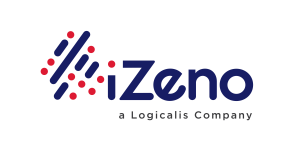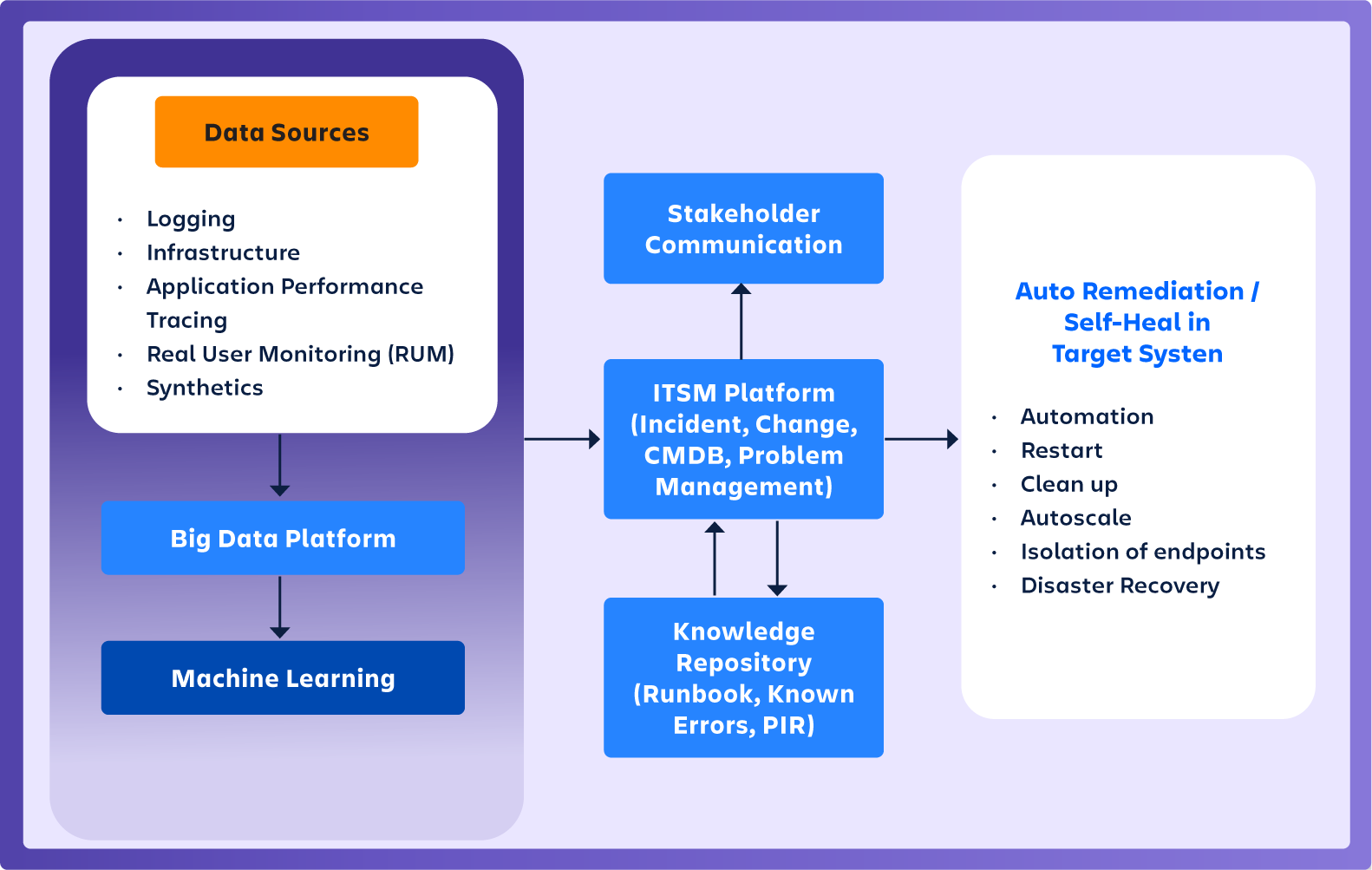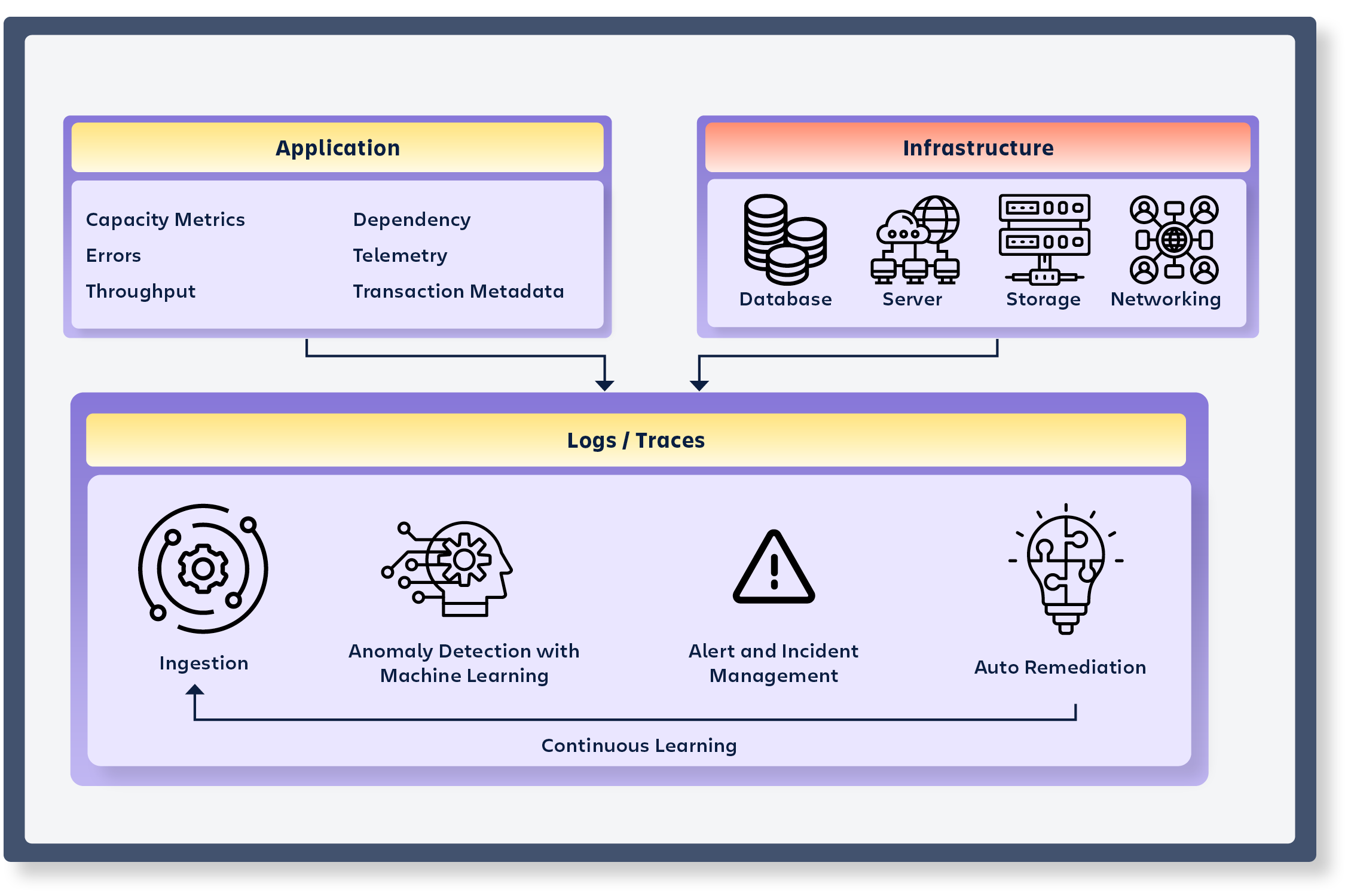Transforming IT Service Management with AIOps (Artificial Intelligence for IT Operations)

As applications evolve from monolithic to microservices and IT infrastructure grows in size and complexity, the challenge of providing effective management and maintenance is intensifying for overburdened IT teams. An over reliance on traditional, manual IT processes can result in inefficiencies, missed opportunities for innovation, and potential gaps in security and compliance. But automation methods like AIOps (artificial intelligence for IT operations) can streamline IT processes while enabling more reliable, secure, and efficient management and maintenance.
AIOps defined
AIOps integrates artificial intelligence (AI) and machine learning (ML) and automates many of the manual detection and maintenance tasks that can consume an IT team’s time. AIOps streamlines and improves the efficiency of IT operations, empowering IT teams to proactively analyze data from multiple sources, rapidly identify areas that need attention within the environment, and gain accurate insights for quick and effective issue resolution. With AIOps, IT professionals have more time to focus on strategic, high-value initiatives.
Key drivers of AIOps
AIOps is a valuable solution for organizations experiencing any of the following conditions:
- Environment complexity: When organizations transition from a monolithic architecture to a microservices-based service architecture while embracing cloud-native principles, their technology stack takes on a level of complexity that's difficult for IT teams with manual processes to monitor and track.
- A need for availability and real-time monitoring: Organizations that want to ensure their services exhibit reliability, responsiveness, and scalability can benefit from AI, which provides exceptional user experiences and helps organizations fulfill their SLAs (service level agreements) while promptly addressing issues.
- High data volume: Within a microservices-based architecture, growing demands for availability and monitoring drive an increase in data volume. AI empowers operations and IT teams to proficiently analyze data and make informed decisions when it comes to anomaly detection and clustering techniques.
- A desire for an improved customer experience: AI allows organizations to achieve faster issue resolution with a minimal impact on users, ensuring a seamless experience.
- Cost burdens: AIOps can lead to significant cost savings by optimizing resource utilization and reducing the need for additional staff. AI can prevent or minimize downtime, automate routine tasks, enhance capacity planning, and support the automated scaling of infrastructure as needed.
AIOps components
The key components of an AIOps platform are often summarized as: observe, engage, act. The AIOps framework's Observe, Engage, Act approach offers a straightforward way for IT service management teams to enhance their operations.
Observe
IT teams can use AIOps to collect and analyze vast amounts of data from various sources within their organization's IT environment. These sources may include logs, metrics, events, and other telemetry data from servers, applications, network devices, and more.
Engage
AIOps facilitates the correlation of data across various sources to provide a holistic understanding of incidents and their potential impact on the organization.
Intelligent alerting and notification systems are an integral part of this component. They ensure IT teams are informed promptly about critical issues that require attention using IT service management solutions with modern incident management capabilities. Using workflow automation, AIOps platforms can route incidents to the appropriate teams or systems for resolution, and they can track the progress of these workflows.
Act
AIOps platforms execute automated or semi-automated actions based on the insights derived from the observation and engagement phases. These actions can include automated remediation, where AIOps can trigger predefined scripts or actions to resolve common issues without the need for human intervention.
The ultimate aim of AIOps is to accelerate incident response, reduce mean time to resolution (MTTR), and improve the overall efficiency of IT operations.
AIOps: an end-to-end solution
When organizations adopt AIOps, they secure an end-to-end solution with three phases that map onto the observe, engage, act framework.
Observability (observe)
With AIOps, IT teams have access to supervised and unsupervised machine learning capabilities for all forms of data including logs, traces, events, and metrics, for both the business as a whole and for operations within the organization.

IT Service Management (engage)
The IT service management, or engage, phase in an AIOps solution orchestrates an organization's incident management process and ensures the right teams are alerted, provided with actionable information, and guided through the resolution process efficiently.
Automation (act)
The automation, or act, phase is an AIOps solution component that focuses on automating actions to resolve issues, improve system stability, and optimize IT operations. This phase leverages predefined conditions and triggers to execute specific tasks automatically, reducing the need for manual intervention and accelerating incident resolution.

Recommended best practices
Implementing AIOps requires careful planning and adherence to best practices to ensure its success. Our recommendations include:
- Identify the current state: Begin by conducting a thorough assessment of your existing IT infrastructure, tools, and processes. Understand how your IT operations currently function, including monitoring and incident management. This baseline assessment helps you identify areas that can benefit from AIOps and provides a clear starting point for improvements.
- Define future objectives: Clearly define your goals and objectives for AIOps implementation. Determine what you want to achieve, such as reducing mean time to resolution (MTTR), improving system availability, or automating routine tasks. These objectives will serve as a roadmap for your AIOps deployment and help measure its success.
- Choose the right tool: Select AIOps tools and solutions that align with your organization's specific needs and objectives. Consider factors like scalability, integration capabilities, ease of use, and the ability to analyze and correlate data from various sources, including logs, metrics, and events.
- Security controls: When integrating AIOps with other systems, especially for data collection and communication, whitelist the necessary IP addresses to enhance security. This helps prevent unauthorized access and ensures that only trusted sources can interact with your AIOps platform. If you're implementing AIOps for on-premises observability, prioritize security measures by implementing encryption and accessing controls to safeguard your data and systems.
- Continual improvement: AIOps is not a one-time implementation; it requires ongoing maintenance and improvement. Continuously monitor the performance of your AIOps platform and refine your algorithms and processes based on feedback and changing IT requirements. This iterative approach ensures that AIOps remains effective in the long term.
- Governance and internal reviews: Establish governance mechanisms and conduct regular internal reviews to assess the effectiveness of your AIOps implementation. Ensure that your AIOps initiatives align with the overall IT strategy and business objectives. Regularly engage stakeholders and solicit their feedback to make improvements.
AIOps offers benefits that can contribute to improved IT operations, enhanced efficiency, cost savings, and better overall business outcomes. With real-time monitoring and the analysis of IT infrastructure, applications, and services, AIOps allows organizations to identify and address issues before they impact end-users. AIOps even allows organizations to proactively detect and remediate issues by analyzing historical data and trends, ensuring a seamless end-user experience. AIOps' predictive analytics aid in long-term planning, helping organizations make informed decisions about infrastructure investments and upgrades.
Was this content helpful?
Connect, share, or get additional help
Atlassian Community